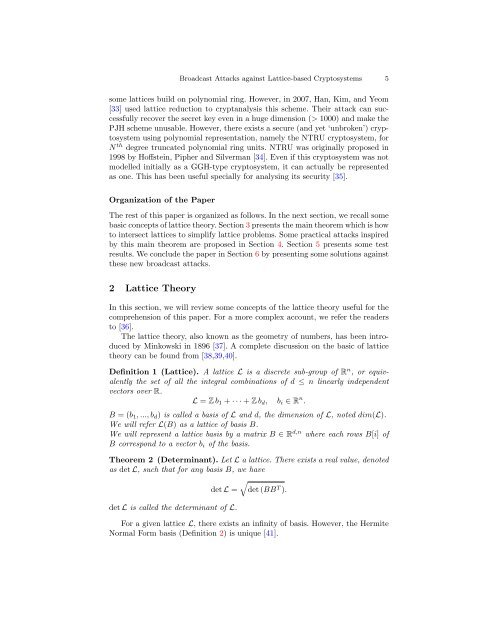Broadcast Attacks against Lattice-based Cryptosystems*
Broadcast Attacks against Lattice-based Cryptosystems*
Broadcast Attacks against Lattice-based Cryptosystems*
You also want an ePaper? Increase the reach of your titles
YUMPU automatically turns print PDFs into web optimized ePapers that Google loves.
<strong>Broadcast</strong> <strong>Attacks</strong> <strong>against</strong> <strong>Lattice</strong>-<strong>based</strong> Cryptosystems 5some lattices build on polynomial ring. However, in 2007, Han, Kim, and Yeom[33] used lattice reduction to cryptanalysis this scheme. Their attack can successfullyrecover the secret key even in a huge dimension (> 1000) and make thePJH scheme unusable. However, there exists a secure (and yet ‘unbroken’) cryptosystemusing polynomial representation, namely the NTRU cryptosystem, forN th degree truncated polynomial ring units. NTRU was originally proposed in1998 by Hoffstein, Pipher and Silverman [34]. Even if this cryptosystem was notmodelled initially as a GGH-type cryptosystem, it can actually be representedas one. This has been useful specially for analysing its security [35].Organization of the PaperThe rest of this paper is organized as follows. In the next section, we recall somebasic concepts of lattice theory. Section 3 presents the main theorem which is howto intersect lattices to simplify lattice problems. Some practical attacks inspiredby this main theorem are proposed in Section 4. Section 5 presents some testresults. We conclude the paper in Section 6 by presenting some solutions <strong>against</strong>these new broadcast attacks.2 <strong>Lattice</strong> TheoryIn this section, we will review some concepts of the lattice theory useful for thecomprehension of this paper. For a more complex account, we refer the readersto [36].The lattice theory, also known as the geometry of numbers, has been introducedby Minkowski in 1896 [37]. A complete discussion on the basic of latticetheory can be found from [38,39,40].Definition 1 (<strong>Lattice</strong>). A lattice L is a discrete sub-group of R n , or equivalentlythe set of all the integral combinations of d ≤ n linearly independentvectors over R.L = Z b 1 + · · · + Z b d , b i ∈ R n .B = (b 1 , ..., b d ) is called a basis of L and d, the dimension of L, noted dim(L).We will refer L(B) as a lattice of basis B.We will represent a lattice basis by a matrix B ∈ R d,n where each rows B[i] ofB correspond to a vector b i of the basis.Theorem 2 (Determinant). Let L a lattice. There exists a real value, denotedas det L, such that for any basis B, we have√det L = det (BB T ).det L is called the determinant of L.For a given lattice L, there exists an infinity of basis. However, the HermiteNormal Form basis (Definition 2) is unique [41].
















